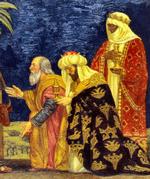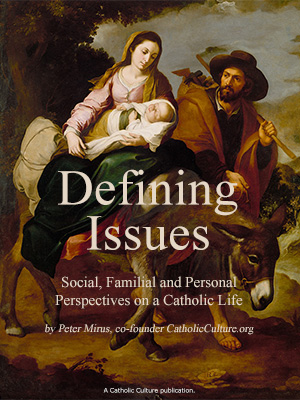Incarnation Reveals Glory of the Trinity
1. "One source and one root, one form shines out in threefold splendour. From the bright depths of the Father bursts forth the power of the Son, the wisdom that created the whole world, the fruit born of the Father's heart! And there blazes the unifying light of the Holy Spirit". So sang Synesius of Cyrene in Hymn II at the beginning of the fifth century, celebrating the divine Trinity, one in source and threefold in glory, at the dawn of a new day. This truth of the one God in three equal and distinct Persons is not relegated to heaven; it cannot be regarded as a sort of "heavenly mathematical theorem" with no implications for human life, as the philosopher Kant supposed.
2. In fact, as we heard in the Evangelist Luke's account, the glory of the Trinity becomes present in time and space and finds its manifestation in Jesus, his Incarnation and his history. Luke interprets the conception of Christ precisely in the light of the Trinity: this is attested by the angel's words to Mary, spoken inside the modest home in the Galilean village of Nazareth, which archaeology has brought to light. The transcendent divine presence is revealed in Gabriel's announcement: the Lord God — through Mary and in the line of David's descendants — gives his Son to the world: "You will conceive in your womb and bear a son, and you shall call his name Jesus. He will be great, and will be called the Son of the Most High; and the Lord God will give to him the throne of his father David" (Lk 1: 31-32).
God manifested his love by sending the Son
3. Here the word "son" has a twofold sense, because the filial bond with the heavenly Father and with the earthly mother are closely united in Christ. But the Holy Spirit also shares in the Incarnation, and indeed it is his action which makes that conception unique and unrepeatable: "The Holy Spirit will come upon you, and the power of the Most High will overshadow you; therefore the child to be born will be called holy, the Son of God" (Lk 1: 35). The angel's words are like a short Creed which sheds light on the identity of Christ in relation to the other Persons of the Trinity. It is the Church's unanimous faith which Luke already places at the dawn of the saving fullness of time: Christ is the Son of the Most High God, the Great One, the Holy One, the King, the Eternal One, whose conception in the flesh takes place through the power of the Holy Spirit. Therefore, as John will say in his First Letter, "no one who denies the Son has the Father. He who confesses the Son has the Father also" (1 Jn 2: 23).
4. At the centre of our faith is the Incarnation, in which the glory of the Trinity and the Trinity's love for us is revealed: "And the Word became flesh and dwelt among us ... we have beheld his glory" (Jn 1: 14). "God so loved the world that he gave his only Son" (Jn 3: 16). "In this the love of God was made manifest among us, that God sent his only Son into the world, so that we might live through him" (1 Jn 4: 9). Through these words of the Johannine writings, we can understand how the revelation of the Trinity's glory in the Incarnation is not a flash of light dispelling the darkness for a moment, but a seed of divine life sown in the world and in human hearts for ever.
In this regard a statement by the Apostle Paul in his Letter to the Galatians is emblematic: "When the time had fully come, God sent forth his Son, born of woman, born under the law, to redeem those who were under the law, so that we might receive adoption as sons. And because you are sons, God has sent the Spirit of his Son into our hearts, crying, "Abba! Father!'. So through God you are no longer a slave but a son, and if a son then an heir" (Gal 4: 4-7; cf. Rom 8: 15-17). The Father, the Son and the Spirit are present and active, then, in the Incarnation in order to involve us in their life. "All men", the Second Vatican Council stressed, "are called to this union with Christ, who is the light of the world, from whom we go forth, through whom we live, and towards whom our whole life is directed" (Lumen gentium, n. 3). And, as St Cyprian stated, the community of God's children is "a people made one with the unity of the Father, the Son and the Holy Spirit" (De Dom Orat., 23).
Trinity is central mystery of Christian faith and life
5. "To know God and his Son is to accept the mystery of the loving communion of the Father, the Son and the Holy Spirit into one's own life, which even now is open to eternal life because it shares in the life of God. Eternal life is therefore that life of God himself and at the same time the life of the children of God. As they ponder this unexpected and inexpressible truth which comes to us from God in Christ, believers cannot fail to be filled with ever new wonder and unbounded gratitude" (Evangelium vitae, nn. 37-38).
In this wonder and acceptance we must adore the mystery of the Holy Trinity, which "is the central mystery of Christian faith and life. It is the mystery of God in himself. It is therefore the source of all the other mysteries of faith, the light that enlightens them" (Catechism of the Catholic Church, n. 234).
In the Incarnation we contemplate the Trinitarian love which is revealed in Jesus: a love that does not remain closed in a perfect circle of light and glory, but shines forth in human flesh and in human history; it pervades man, giving him new birth as a son in the Son. For this reason, as St Irenaeus said, the glory of God is the living man: "Gloria enim Dei vivens homo, vita autem hominis visio Dei". He is not so only because of his physical life, but especially because "man's life consists in the vision of God" (Adversus Haereses IV, 20, 7). And to see God is to be transfigured in him: "We shall be like him, for we shall see him as he is" (1 Jn 3: 2).
To the English-speaking pilgrims and visitors the Holy Father said:
I am happy to welcome to this audience the many school groups, as well as the parish and diocesan pilgrimages, especially from Denmark, Finland, Australia, the Philippines, Japan and the United States. As you pray at the tombs of the Apostles Peter and Paul, may you be strengthened in your faith and in your resolve to serve Christ in others. Upon you and your families I invoke the joy and peace of the risen Saviour.
© L'Osservatore Romano, Editorial and Management Offices, Via del Pellegrino, 00120, Vatican City, Europe, Telephone 39/6/698.99.390.
This item 2711 digitally provided courtesy of CatholicCulture.org






